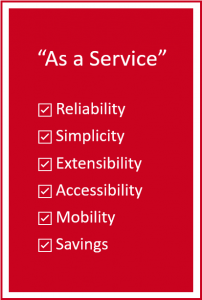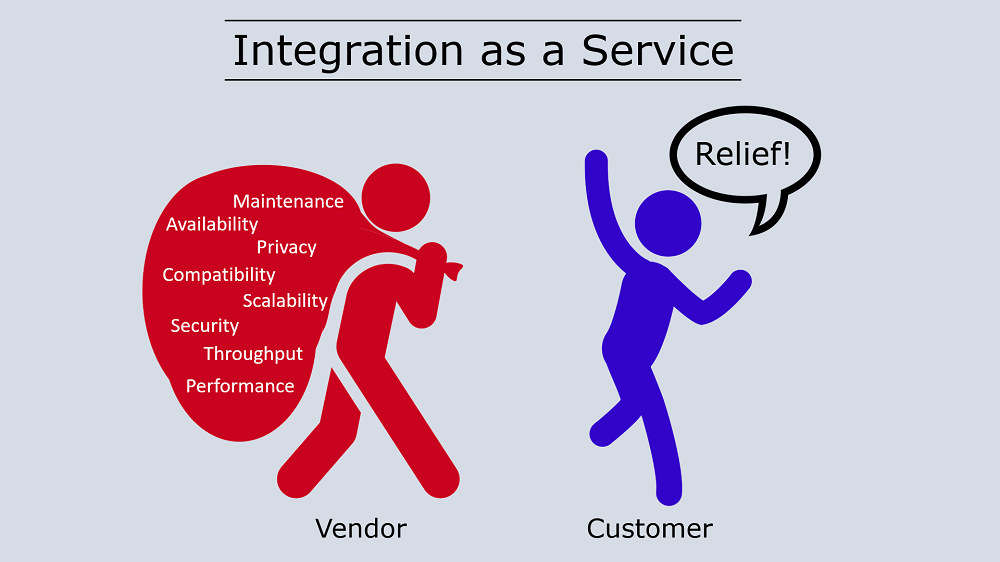The Case for Integration as a Service
The turn of the millennium saw a rise of software as a service (SaaS). Until then, companies used applications locally installed on each computer to drive most of their business.
But as companies partnered with vendors who offered SaaS, those companies did so to gain a number of benefits.
Benefits of “As a Service”
If you worked with software during the transition to SaaS, you likely welcomed these benefits:
 1. Reliability. In SaaS, the burden is on the vendor to ensure that the software works. And when the software works, it works for all the vendor’s customers. If the service is down for all customers, the vendor faces the risk of losing many of them, raising the vendors’ motivation to make sure that the software works for all customers. No more wondering whether data is lost when a local hard drive fails. No more having to send an IT technician to investigate a local install.
1. Reliability. In SaaS, the burden is on the vendor to ensure that the software works. And when the software works, it works for all the vendor’s customers. If the service is down for all customers, the vendor faces the risk of losing many of them, raising the vendors’ motivation to make sure that the software works for all customers. No more wondering whether data is lost when a local hard drive fails. No more having to send an IT technician to investigate a local install.
2. Simplicity. Companies subscribing to SaaS pay the vendor to worry about servers, server connections, other hardware, and installations of updates.
3. Extensibility. Rather than needing to figure out how to expand software access and features as the number of users and business needs grow, SaaS subscribers simply pay more for the additional services—and even then, the needed services may be included in the plan.
4. Accessibility and mobility. With SaaS, users need not worry about whether a certain device “has” a needed application. As long as the user finds an internet-connected device, the user has access to the app from anywhere.
5. Savings. The subscription model reduces the cost of entry, letting subscribers discontinue payment when they discontinue their subscription.
What is Integration as a Service?
These SaaS benefits are often similar in other “as a service” models, whether infrastructure as a service, platform as a service, or any number of other cloud services.
Let’s apply this model and these benefits to integration. What does integration as a service mean for you?
In short, it means that the burden shifts from your shoulders to the vendor’s. Upgrades, outages, version compatibility, and so forth are not problems for you—but for the vendor to take care of behind the scenes.
More Than a Platform, More Than iPaaS
Integration as a service is not the same as integration platform as a service (iPaaS). With iPaaS, the only service delivered “as a service” is the platform–how the vendor delivers their product to you.
Getting iPaaS means getting a platform as a service–a platform on which you build (and maintain) all your own integrations. You get a place where you’re responsible to set up, maintain, and add extensive coding for your integrations.
It’s like going to your physician for a check up and being handed a stethoscope and tongue depressor.
True Integration as a Service

In contrast to iPaaS, integration as a service is not just the platform that the vendor takes care of. You can relax about a number of concerns that the vendor takes on:
- Security. The vendor uses secure facilities and network. Only the customer holds data-encryption keys that the integration uses through native applications.
- Availability. Integration with “store and forward” architecture ensures that your data always gets to where it’s needed.
- Scalability. Exchange as much data as you need, including attachments, work notes and related items.
- Privacy. Inbuilt data obfuscation capabilities ensure that PII data is not shared unintentionally.
- Compatibility. Ensure that all versions of all your applications continue to work together – even if you swap them out.
- Maintenance. Confidently upgrade your applications knowing that your integrations will keep working.
- Throughput. Move even tens of millions of transactions every day, if you want, without even breaking a sweat.
- Performance. Ensure performance not just of integrations, but all of the integrated applications as well.
“Here, Let Me Get That for You”
In the face of complex and overwhelming challenges, it’s nice to get some help. Have you been given the task to integrate systems and maintain those integrations? Let your responsibility become the vendor’s responsibility.
Want to learn more about bringing integration as a service to your business? Let’s chat.









